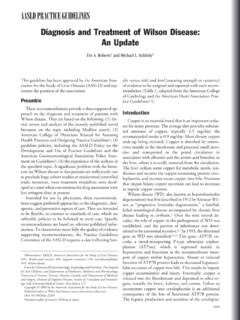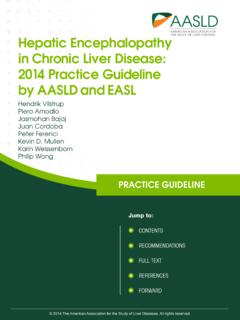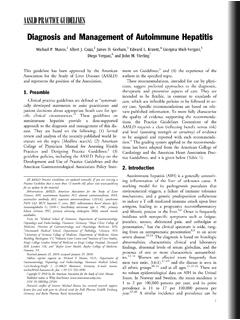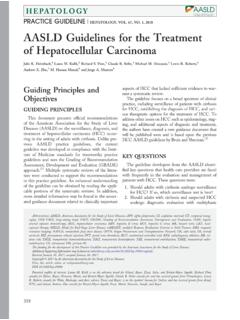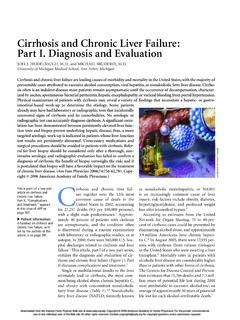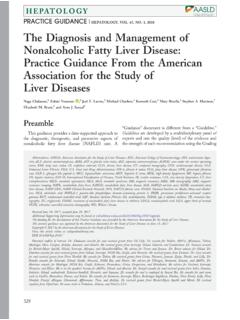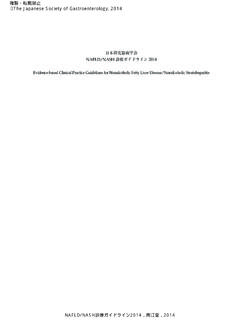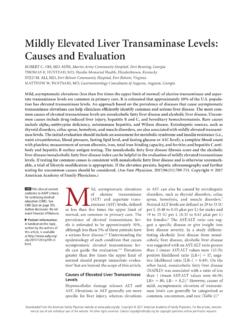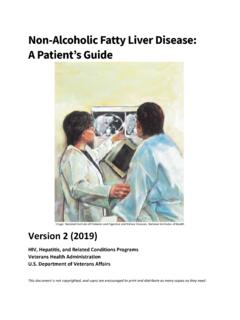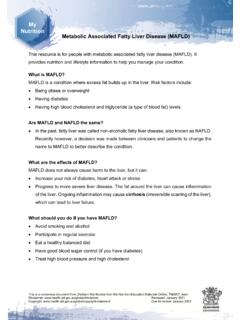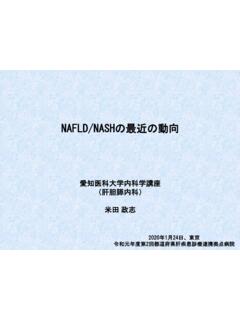Transcription of Diagnosis, Staging, and Management of Hepatocellular ...
1 723 PRACTICE GUIDANCE|Hepatology, Vol. 68, No. 2, 2018 VIRAL HEPATITISD iagnosis, Staging, and Management of Hepatocellular Carcinoma: 2018 Practice Guidance by the American Association for the Study of liver DiseasesJorge a. Marrero,1 laura M. Kulik,2 Claude B. Sirlin,3 andrew X. Zhu,4 Richard S. Finn,5 Michael M. abecassis,2 lewis R. Roberts,6 and Julie K. Heimbach6 Purpose and ScopeThis guidance provides a data-supported approach to the diagnosis, staging, and treatment of patients diag-nosed with Hepatocellular carcinoma (HCC). A guid-ance document is different from a guideline.
2 Guidelines are developed by a multidisciplinary panel of experts who rate the quality (level) of the evidence and the strength of each recommendation using the Grading of Recommendations Assessment, Development, and Evaluation system (GRADE). A guidance document is developed by a panel of experts in the topic, and guidance statements, not recommendations, are put forward to help clinicians understand and implement the most recent for HCC were recently developed accord-ing to the GRADE The Guidelines for HCC were developed using clinically relevant questions, which were then answered by systematic reviews of the literature, and followed by data-supported recommendations.
3 (2) The Guidelines focused on surveillance, diagnosis, and treatment of HCC. However, some areas of HCC lacked sufficient data to perform systematic reviews, and here the authors will update the 2010 American Association for the Study of liver Diseases (AASLD) Guidelines,(3) hereto referred as the guidance for : A ASLD, American Association for the Study of liver Diseases; AFP, alpha-fetoprotein; ALD, alcoholic liver disease ; BCLC, Barcelona Clinic liver Cancer; CCA, cholangiocarcinoma; CEUS, contrast-enhanced ultrasound; CI, confidence interval; CSPH, clinically significant portal hypertension.
4 CT, computed tomography; DA A, direct-acting antiviral; DCP, des gamma carboxy prothrombin; DEBs, drug-eluting beads; ECOG, Eastern Cooperative Oncology Group; FDA, Food and Drug Administration; HBV, hepatitis B virus; HCC, Hepatocellular carcinoma; HCV, hepatitis C virus; HKLC, Hong Kong liver Cancer; HR, hazard ratio; IFN, interferon; LC, liver cirrhosis; LI-R ADS, liver Imaging Reporting and Data System; LRT, locoregional therapy; LT, liver transplant; MELD, Model for End-Stage liver disease ; MRI, magnetic resonance imaging; nafld , nonalcoholic fatty liver disease ; OPTN, Organ Procurement and Transplantation Network; OS, overall survival; PAF, population attributable fraction; PBC, primary biliary cholangitis; PD-1, programmed cell death protein 1; PH, portal hypertension; PS, performance status; RCTs, randomized controlled trials; RFA, radiofrequency ablation; SBRT, stereotactic body radiotherapy; TARE, transarterial radioembolization; SVR, sustained virological response; TACE, transarterial chemoembolization; TTP, time to progression.
5 US, 12 March 2018; Accepted 13 March 2018 The funding for the development of this Practice Guidance was provided by the American Association for the Study of liver Practice Guidance was approved by the American Association for the Study of liver Diseases on February 23, 2018. 2018 by the American Association for the Study of liver this article online at conflict of interest: Dr. Finn consults for Bayer, Bristol-Myers Squibb, Eisai, Eli Lilly, Merck, Pfizer, and Novartis. Dr. Marrero advises for Eisai and Grail. He is on the data safety board for AstraZeneca.
6 Dr. Zhu consults for Bayer, Eisai, Bristol-Myers Squibb, Merck, and Exelixis. Dr. Roberts consults for and received grants from Wako. He consults for Medscape and Axis. He advises for Bayer, Grail, and Tavec. He received grants from Ariad, BTG, Gilead, and Redhill. Dr. Kulik consults for Bristol-Myers Squibb, Bayer, Eisai, BTG, and Grail. Dr. Sirlin is on the speakers' bureau for and received grants from GE Healthcare, MRI, Digital, US, and Bayer. He consults for Boehringer Ingelheim. He advises for AMR A and Guerbet. He received grants from Siemens, Gilead, Virtualscopic, Shire, Intercept, Philips, ICON/Enanta, and ACR et al.
7 Hepatology, august 2018724 Intended for use by health care providers, this guid-ance is meant to supplement the recently published HCC Guidelines in order to provide updated infor-mation on the aspects of clinical care for patients with HCC. As with other guidance documents, it is not intended to replace clinical judgment, but rather to provide general guidance applicable to the majority of patients. They are intended to be flexible, in contrast to formal treatment recommendations, and clinical con-siderations may justify a course of action that differs from this is now the fifth-most common cancer in the-world and the third cause of cancer-related mortality as estimated by the World Health Organization ( ).
8 It is estimated that in 2012, there were 782,000 cases worldwide, of which 83% were diag-nosed in less developed regions of the world. The an-nual incidence rates in eastern Asia and Sub-Saharan Africa exceed 15 per 100,000 inhabitants, whereas fig-ures are intermediate (between 5 and 15 per 100,000) in the Mediterranean Basin, Southern Europe, and North America and very low (below 5 per 100,000) in Northern Europe.(4) Vaccination against hepati-tis B virus (HBV) has resulted in a decrease in HCC incidence in countries where this virus was highly prevalent.
9 (5) These data suggest that the geographical heterogeneity is primarily related to differences in the exposure rate to risk factors and time of acquisition, rather than genetic predisposition. Studies in migrant populations have demonstrated that first-generation immigrants carry with them the high incidence of HCC that is present in their native countries, but in the subsequent generations the incidence decreases.(6)The age at which HCC appears varies according to sex, geographical area, and risk factor associated with cancer development.
10 In high-risk countries with major HBV prevalence, the mean age at diagnosis is usually below 60 years; however, it is not infrequent to observe HCC from childhood to early adulthood, underlying the impact of viral exposures early in life.(7) In interme-diate- or low-incidence areas, most cases appear beyond 60 years of age. In African and Asian countries, the diag-nosis of HCC at earlier ages is attributed to a synergy between HBV and dietary aflatoxins, which is thought to induce mutations in the TP53 gene.(8) Other factors such as insertional mutagenesis and family history could play a role in the development of HCC at earlier ages.

